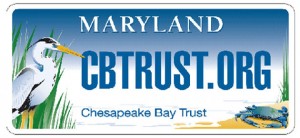[do action=”schuh”/]
 Last week, the Chesapeake Bay Trust announced the latest class of 32 young people to join the 2015 Chesapeake Conservation Corps program. This program, created by the Maryland Legislature in 2010, matches youth, ages 18-25, with a variety of organizations, including watershed groups, government agencies, local schools, and area nonprofits, for a one-year term of service. During the year, Conservation Corps participants will gain valuable on-the-job experience and career skills while they work to advance environmental conservation and a host of other environmentally-focused initiatives. Today, 32 Corps participants met their host organizations and learned more about what to expect during their terms of service. The event was held at the Eastport Yacht Club in Annapolis which was the first yacht club in Maryland to have a Clean Marina certification and has instituted their own environmental best management practices, including the installation of rain gardens and pervious pavement on their property.
Last week, the Chesapeake Bay Trust announced the latest class of 32 young people to join the 2015 Chesapeake Conservation Corps program. This program, created by the Maryland Legislature in 2010, matches youth, ages 18-25, with a variety of organizations, including watershed groups, government agencies, local schools, and area nonprofits, for a one-year term of service. During the year, Conservation Corps participants will gain valuable on-the-job experience and career skills while they work to advance environmental conservation and a host of other environmentally-focused initiatives. Today, 32 Corps participants met their host organizations and learned more about what to expect during their terms of service. The event was held at the Eastport Yacht Club in Annapolis which was the first yacht club in Maryland to have a Clean Marina certification and has instituted their own environmental best management practices, including the installation of rain gardens and pervious pavement on their property.
“The Chesapeake Conservation Corps Program continues to flourish and provides an excellent opportunity for young people to gain the valuable job skills they need in order to protect Maryland’s most treasured natural resources,” said Senate President Thomas V. Mike Miller, Jr., the lead sponsor of the legislation that created this program. “Not only does this program provide valued jobs to young people in Maryland, but it also offers Corps participants the opportunity to play a vital role in the Bay restoration effort.”
Since the program began 2010 it has grown steadily in popularity with more than 135 applications received for just 32 coveted volunteer spots and more than 75 groups vying to serve as host organizations. This year also marks a new opportunity for partners to invest in the program. Five groups this year, the National Park Service, the Environmental Protection Agency, the U.S. Fish and Wildlife Service, Arlington Echo, and Environmental Concern all invested their own dollars to increase program participation levels, expanding opportunities for host organizations and allowing additional young people to get the training they need to advance their careers. Partner funds through EPA under this new opportunity have also enabled the program to expand beyond Maryland for the very first time to Washington, D.C.
“Training and educating the next generation on how to protect our environment is crucially important if we want to be able to restore our Chesapeake Bay and its many rivers and streams,” said Congressman John Sarbanes, author of the No Child Left Inside Act and representative for Maryland’s third Congressional district. “I have been a strong supporter of the Chesapeake Conservation Corps since it began because this program accomplishes so many important things: it advances Bay restoration efforts; it offers educational opportunities for young people; and it provides valuable jobs in Maryland.”
This year’s class will work on tasks as varied as their backgrounds, including watershed restoration, environmental education, forestry and stormwater management, as well as provide underserved youth with educational and job training programs. Some participants are recent college graduates; others enter the program immediately after high school to gain insight into a possible career in environmental protection and management. The program also has served as vehicle for full time employment as each year between 20-50 percent of Corps participants are hired by their host organizations as employees after their initial term of service is completed.
The program is funded by both the state of Maryland and the Chesapeake Bay Trust, with a generous contribution provided by Constellation Energy and new funding partnerships with NPS, EPA, FWS, Arlington Echo, and Environmental Concern. Program participants are provided with a stipend and health insurance for one year in addition to technical training provided by the Chesapeake Bay Trust. Corps participants also have an opportunity to apply for grants from the Trust to learn grant writing skills and how to implement projects. During the opening event, Senator John Astle and Delegate Shane Robinson (both sponsors of legislation related to the Corps), addressed the Class of 2015, in addition to Maryland Department of Natural Resources Secretary Joseph Gill representing the state and John Quinn on behalf of Constellation.
“The Chesapeake Conservation Corps program attracts so many talented candidates each year and we are pleased to see it expanded this year as a result of the additional support of so many new partners and organizations,” said Jana Davis, executive director of the Chesapeake Bay Trust. “This year’s class will accomplish great things to help our environment and we are honored to have partnered with the state of Maryland and Constellation Energy since this program began.”
Of the 32 selected participants, eight (8) will work for organizations in Anne Arundel County, six (6) will work in Baltimore City and County, five (5) in Montgomery, three (3) in Prince George’s, two (2) in Frederick, one (1) in Howard, one (1) in Carroll, one (1) in Washington, D.C., and five (5) will work with organizations located on Maryland’s Eastern Shore. The 2015 Chesapeake Conservation Corps class includes the following individuals and their host organizations:
- Albert Leavell, Chester River Association, Kent County
- Amelia Marcus, Banner Neighborhoods Community Corps, Baltimore City
- Ashley McAvoy, Hood College Center for Coastal & Watershed Studies, Frederick County
- Audrey Pleva, Anacostia Watershed Society, Prince George’s County
- Audrey Seiz, U.S. Fish and Wildlife Service, Anne Arundel County
- Augusta Maguire, Morgan State University, Baltimore City
- Bethany Enyeart, Arlington Echo Outdoor Education Center, Anne Arundel County
- Christine Burns, Midshore Riverkeeper Conservancy, Talbot County
- Daniel Foster, The Nature Conservancy, Montgomery County
- Daniel Saltzberg, Frederick County Office of Sustainability & Environmental Resources, Frederick County
- Emily Forinash, William S. Schmidt Outdoor Education Center, Prince George’s County
- James Rush, National Park Service, Anne Arundel County
- Joanne Maturana, Nanticoke Watershed Alliance, Dorchester County
- Julia Poust, Chesapeake Bay Foundation, Anne Arundel County
- Kerry Maguire, Arlington Echo Outdoor School, Anne Arundel County
- Kyle Hinson, Watershed Stewards Academy, Anne Arundel County
- Marlo Atkinson, U.S. Fish & Wildlife Service, Anne Arundel County
- Maura Duffy, National Aquarium in Baltimore, Baltimore City
- Michael Weitekamp, Latin American Youth Center, Montgomery County
- Nguyen Le, Interstate Commission on the Potomac River Basin, Montgomery County
- Nicholas Ryugo, University of Maryland Environmental Finance Center, Prince George’s County
- Noelia Roman-Ramos, Montgomery Parks Meadowside Nature Center, Montgomery County
- Patrice Matthews, Baltimore County Department of Environmental Protection and Sustainability, Baltimore County
- Patrick Ma, Maryland Forest Service, Carroll County
- Payton Brown, Alliance for the Chesapeake Bay, Anne Arundel County
- Rebecca Weisberg, Environmental Concern/Eastern Shore Land Conservancy, Talbot County
- Ryan Gradel, Howard County Conservancy, Howard County
- Samantha Roth, Audubon Naturalist Society, Montgomery County
- Shanita Brown, Earth Conservation Corps, Washington, D.C.
- Shelby Erwin, Pearlstone Center, Baltimore County
- Skyla Steele, Irvine Nature Center, Baltimore County
- Zoe Rosenblum, Environmental Concern, Talbot County
[do action=”blackwall-hitch”/]









































